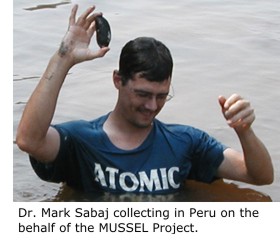| Page last updated
7 September 2005 |
The Adventures of Dr. Mark Sabaj in South America, part II
 In August of 2005, Dr. Mark Sabaj of the Academy of Natural Sciences and his colleagues visited Iquitos, Peru for an ichthyological survey. While they were there, they collected a number of freshwater mussels that they donated to the MUSSEL Project. Dr. Sabaj submitted the following report: In August of 2005, Dr. Mark Sabaj of the Academy of Natural Sciences and his colleagues visited Iquitos, Peru for an ichthyological survey. While they were there, they collected a number of freshwater mussels that they donated to the MUSSEL Project. Dr. Sabaj submitted the following report:
"Although the 2005 joint expedition to Iquitos, Peru, targeted parasites and fishes, water levels were incredibly low - meaning that mussels also were within reach. Conditions matched that of a previous expedition to Iquitos in 1997 during which a large mussel bed was found in the Río Itaya a short distance upstream from its confluence with the Río Amazonas. So, we returned to this productive site in hopes of finding the mussels that eluded my 2003 trip to Iquitos (funded in part by a MUSSELp grant from DGL). And find them we did!
 "The day began as our team borrowed a canoe from Sixto Nautino Sabino, a fisherman and honorary mayor of Belén, a "working-class" community on the lower Itaya. We enlisted a couple of Sixto's fishermen to motor us upstream. About 90 minutes up from Puerto Belén (S 3°49'59", W 73°18'07") the conditions looked right (e.g., silt/mud banks, moderate current, submerged trunks and woody debris) and we entered the murky water. "The day began as our team borrowed a canoe from Sixto Nautino Sabino, a fisherman and honorary mayor of Belén, a "working-class" community on the lower Itaya. We enlisted a couple of Sixto's fishermen to motor us upstream. About 90 minutes up from Puerto Belén (S 3°49'59", W 73°18'07") the conditions looked right (e.g., silt/mud banks, moderate current, submerged trunks and woody debris) and we entered the murky water.
"Within a minute, we had our first, second and third mussel. And after an hour or two of hand-picking along shore we managed to collect nearly 200 specimens of 7 or 8 species from which 21 tissue samples were taken. Perhaps the most striking of the Itaya's mussels is the "smooth double heelsplitter", Prisodon obliquus, a species that lends itself to artistic photos. The rarest catch was a single specimen of the "mushroom foot", Mycetopoda sp., a species that lends itself to suberotic photos. A hot spot discovered by one of our guides in the root tangle of a large submerged tree trunk yielded a shirt-load of bivalvular bounty.
"Of course the day was not without fishes, as the submerged logs were home to loricariid catfishes such as this Panaque changae, a species co-authored by Jon Armbruster and described from specimens collected during the 1997 expedition.
"All in all it was a fun and successful day...capped off with a celebratory bottle of ron Cabo Blanco as our team motored back to Iquitos.
 "For help collecting mussels I thank Sixto and his crew of fishermen, our Peruvian hosts Linder Isuiza and César Sias Arrarte, and the members of the expedition team: Mariangeles Arce (ichthyologist, Univ. Nac. de Colombia, Bogotá), Ash Bullard (parasitologist, Univ. Southern Mississippi), Otto Castillo (ichthyologist, Univ. Nac. Experimental de los Llanos Occidentales Ezequiel Zamora, Guanare, Venezuela), Carlos DoNascimiento (ichthyologist, Museo de Historia Natural La Salle, Caracas, Venezuela), M. Cristina Pérez (teacher, Friends Central H.S., Philadelphia) and Scott Snyder (parasitologist, Univ. Nebraska, Omaha). This expedition was funded by the All Catfish Species Project (NSF DEB-0315963) and a project entitled 'Revitalizing taxonomic expertise in Digenea for the 21st century: the haploporid monographs' led by Robin Overstreet (Univ. Southern Mississippi) and recently funded by the NSF PEET program." "For help collecting mussels I thank Sixto and his crew of fishermen, our Peruvian hosts Linder Isuiza and César Sias Arrarte, and the members of the expedition team: Mariangeles Arce (ichthyologist, Univ. Nac. de Colombia, Bogotá), Ash Bullard (parasitologist, Univ. Southern Mississippi), Otto Castillo (ichthyologist, Univ. Nac. Experimental de los Llanos Occidentales Ezequiel Zamora, Guanare, Venezuela), Carlos DoNascimiento (ichthyologist, Museo de Historia Natural La Salle, Caracas, Venezuela), M. Cristina Pérez (teacher, Friends Central H.S., Philadelphia) and Scott Snyder (parasitologist, Univ. Nebraska, Omaha). This expedition was funded by the All Catfish Species Project (NSF DEB-0315963) and a project entitled 'Revitalizing taxonomic expertise in Digenea for the 21st century: the haploporid monographs' led by Robin Overstreet (Univ. Southern Mississippi) and recently funded by the NSF PEET program."
For more information about Dr. Sabaj and his research, click here. |